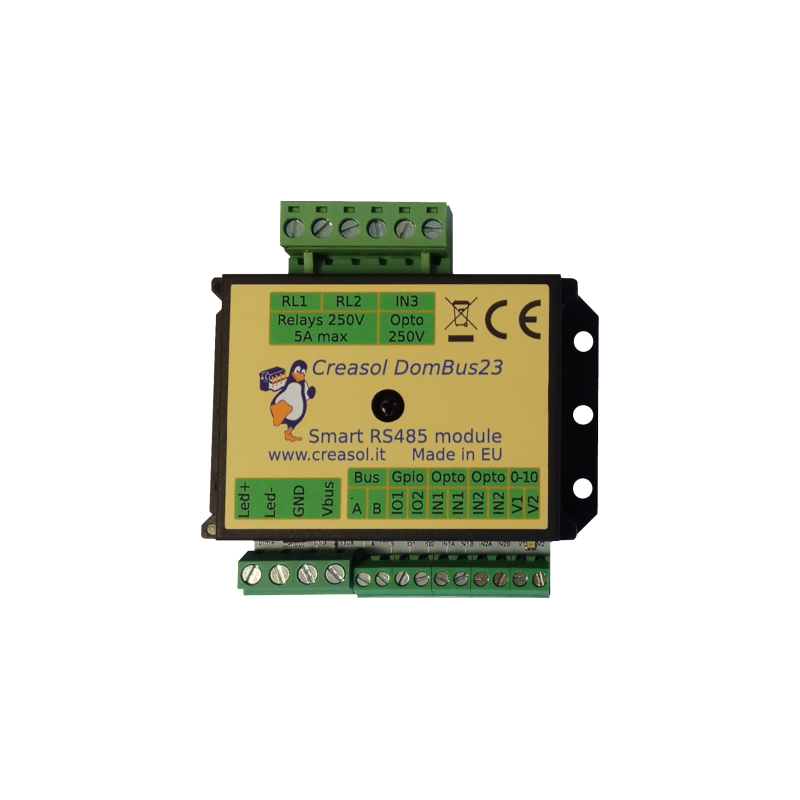

Email: store@creasol.it - Telegram: CreasolTech - Whatsapp: +393283730010
Priority mail: nopea ja edullinen - Pikakuriiri: nope
Ota yhteyttä ennen tuotteiden palautusta!

Creasol DomBus23 on moduulikodin automaatiojärjestelmälleuseita erilaisia tuloja / lähtöjälyhyessä koossa: 74x72x24mm. p>
Se voidaan liittää Domoticz-ohjaimeen RS485-sarjaväylällä (4 johtoa, 2 12 / 24V virtalähteelle ja 2 tiedonsiirrolle nopeudella 115200 bps).
Kuten muutkin DomBus-laitteet,DomBus23 on suunniteltu kuluttamaan vähän virtaa, olemaan luotettava, täysin konfiguroitava ja helppokäyttöinen.
 Täysi tuki: suurin osa tuotteista on meidän suunnittelemamme!
Täysi tuki: suurin osa tuotteista on meidän suunnittelemamme!
Email: store@creasol.it - Telegram: CreasolTech - Whatsapp: +393283730010
 Tilaukset toimitetaan 1 työpäivän sisällä
Tilaukset toimitetaan 1 työpäivän sisällä
Priority mail: nopea ja edullinen - Pikakuriiri: nope
 24 kuukauden takuu, helppo palautus/palautus
24 kuukauden takuu, helppo palautus/palautus
Ota yhteyttä ennen tuotteiden palautusta!
Creasol DomBus23 on moduulikodin automaatiojärjestelmälleuseita erilaisia tuloja / lähtöjälyhyessä koossa: 74x72x24mm. p>
Se voidaan liittää kodin automaatio-ohjaimeen RS485-sarjaväylällä (4 johtoa, 2 12 / 24V-virtalähteelle ja 2 datanopeudelle 115200 bps).
Tuetut kodiautomaatiojärjestelmän ohjaimet ovatDomoticz.
Kuten muutkin DomBus-laitteet,DomBus23 on suunniteltu kuluttamaan vähän virtaa, olemaan luotettava, täysin konfiguroitava ja helppokäyttöinen.
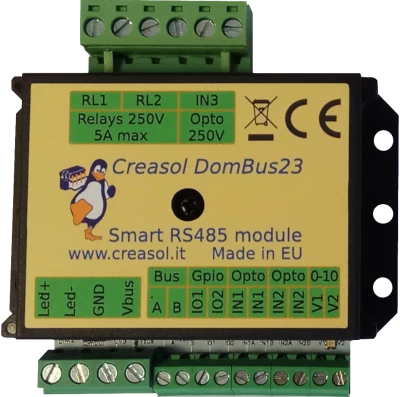
p>
vahva>
Lisätietoja osoitteessa https://www.creasol.it/CreasolDomBus23
Oletusosoite: 0xff23
| Portti # | Nimi | Kyvyt | Oletuskokoonpano | Kuvaus |
| 1 | RL1 | OUT_DIGITAL, OUT_RELAY_LP, OUT_BLIND | OUT_RELAY_LP | SPST-relelähtö, 250Vac 5A kosketusnopeudella tai 30Vdc 5A kosketusnopeudella. Releen kosketin on suojattu ylijännitteeltä varistorilla |
| 2 | RL2 | OUT_DIGITAL, OUT_RELAY_LP, OUT_SOKEA | OUT_RELAY_LP | SPST-relelähtö, 250Vac 5A kosketusnopeudella tai 30Vdc 5A kosketusnopeudella. Releen kosketin on suojattu ylijännitteeltä varistorilla |
| 3 | MOS | OUT_DIGITAL, OUT_DIMMER | OUT_DIMMER | Mosfet-avoimen tyhjennyksen lähtö, 30 V 12A max, soveltuu led-raitojen ohjaamiseen (mahdollisuus säätää kirkkautta DomBus-himmennystoiminnolla, 0-100% 5%: n askelella) tai muilla tasavirtakuormilla. |
| 4 | V1 / OD1 | OUT_ANALOG, OUT_DIGITAL, OUT_RELAY_LP, OUT_BLIND | OUT_ANALOG |
Analogialähtö, 0-10 V, sopiva toisen elektronisen piirilevyn (himmennin, lämpöpumppu, lineaarinen venttiili ...) 0-10 V tai 1-10 V tulon ohjaamiseen. |
| 5 | V2 / OD2 | OUT_ANALOG, OUT_DIGITAL, OUT_RELAY_LP, OUT_BLIND(1) | OUT_ANALOG | OAnalog-lähtö, 0-10 V, sopii toisen elektronisen piirilevyn (himmennin, lämpöpumppu, lineaarinen venttiili ...) 0-10 V tai 1-10 V tulon ohjaamiseen. Vaihtoehtoisesti on mahdollista määrittää tämä portti avoimen tyhjennyksen lähdöksi 40 V 100 mA, joka voidaan liittää ulkoisiin ledeihin tai releeseen käyttämällä valinnaista 5-johtoista kaapelia:od2pcb-hyppääjä on oikosuljettava tässä tapauksessa. |
| 6 | IO1 | IN_DIGITAL,IN_ANALOG, IN_TWINBUTTON, IN_COUNTER, OUT_DIGITAL, OUT_BLIND, OUT_DIMMER, OUT_BUZZER | IN_DIGITAL |
Analoginen / digitaalinen tulo, jota voidaan käyttää jännitteiden lukemiseen tai joka voidaan liittää koskettimeen, kytkimeen, magneettiseen anturiin, PIR: ään, ... |
| 7 | IO2 | IN_DIGITAL, IN_ANALOG, IN_TWINBUTTON, IN_COUNTER, OUT_DIGITAL, OUT_BLIND(1), OUT_DIMMER, OUT_BUZZER | IN_DIGITAL | Analoginen / digitaalinen tulo, jota voidaan käyttää jännitteiden lukemiseen tai joka voidaan liittää koskettimeen, kytkimeen, magneettiseen anturiin, PIR: ään, ... Se voidaan konfiguroida laskuriksi ja kytkeä energia / kaasu / vesimittariin. Se voidaan määrittää nimellä IN_TWINBUTTON (joka voidaan liittää kaksinkertaiseen painikkeeseen) oikosulkemalla piirilevyn hyppyjohdinRU2tai 10 mA: n LÄHTÖ oikosulkemalla piirilevyn hyppyjohdinRO2: jälkimmäisessä tapauksessa sitä voidaan käyttää matalavirtaisena 3 V: n ulostulona, kytkettynä summeriin tai kelaohjaimen sisällä olevaan relekorttiin. |
| 8 | KOHDASSA 1 | IN_AC | IN_AC, IN_COUNTER | Pienjännitetulo, 9-40 V AC tai DC, optoeristetty. Sopii aistimaan läsnäoloJännite |
| 9 | IN2 | IN_AC | IN_AC, IN_COUNTER | Pienjännitetulo, 9-40 V AC tai DC, optoeristetty. Soveltuu jännitteen läsnäoloon |
| 10 | IN3 | IN_AC | IN_AC, IN_COUNTER | 230 V: n tulo, optoeristetty. Soveltuu jännitteen havaitsemiseksi ja sähkökatkoksen havaitsemiseksi (sähkökatkos) |
(1): voidaan käyttää BLIND-ulostulona kaihtimen / verhon avaamiseen, mutta vain edellinen portti voidaan määrittää Domoticzissa nimellä OUT_BLIND, koska kun OUT_BLIND on määritetty, DomBus-laite määrittää seuraavan portin ajamaan releä avoimessa tilassa suunta.
DomBus23-moduuli voi olla käyttöliittymä Domoticzin kanssa ja käyttämällä sisäistä mosfetiä 30 V 12 A: lla, se voi säätää sisäisesti led-nauhan kirkkautta.
Lisäksi DomBus23: ssa on 2 analogista lähtöä 0-10 V, jotka mahdollistavat 2 ylimääräisen led-raidan ohjaamisen ulkoisella led-himmentimellä.

Seuraava kaavio näyttää, kuinka portinavaaja tai autotallin oven avaaja kytketään DomBus23-moduuliin, joka sallii portin ja autotallin oven ohjaamisen kotiautomaatiojärjestelmällä (Domoticz, ...)
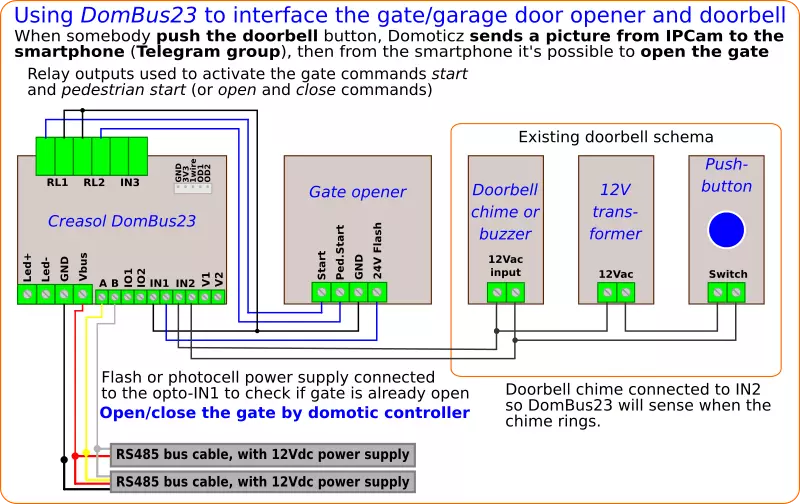
Lisätietoja osoitteessa https://www.creasol.it/CreasolDomBus23
The following video shows a presentation of some domotic modules designed and produced in Italy by Creasol to make a reliable, easy and power-optimized home automation system.
The next video shows our Smart EVSE module that can be used to charge the electric car by using only solar power, or adding 25/50/75/100% of available power from the electrical grid.
Our industrial and home automation modules are designed to be
Modules are available in two version:
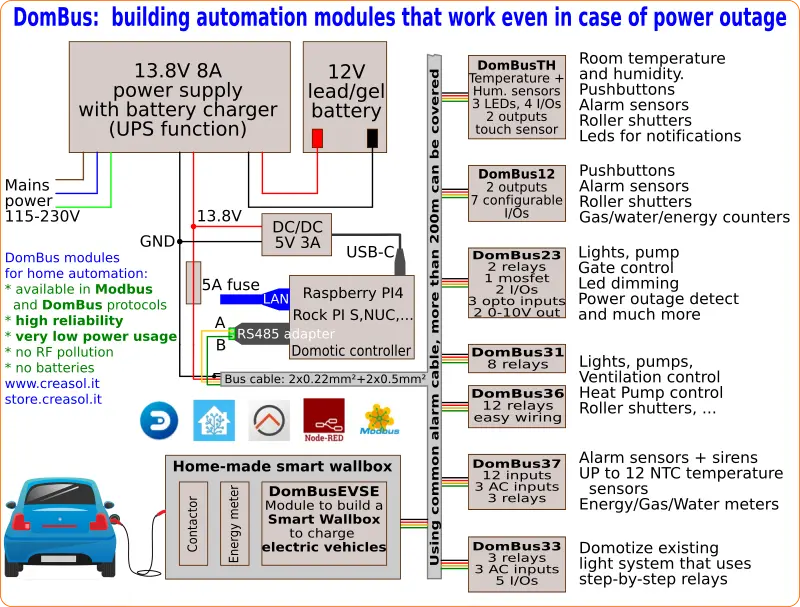
Store website - Information website
For our products we can offer FULL SUPPORT and CUSTOMIZATION: please contact us by Email or Telegram
 Complete solution to make a Smart EVSE, charging the electric vehicle using only energy from renewable source (photovoltaic, wind, ...), or adding 25-50-75-100% of available power from the grid.
Complete solution to make a Smart EVSE, charging the electric vehicle using only energy from renewable source (photovoltaic, wind, ...), or adding 25-50-75-100% of available power from the grid.
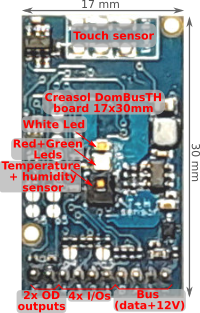 Compact board, 32x17mm, to be installed on blank cover with a 4mm hole in the middle, to exchange air for the relative humidity sensor. It can be installed in every room to monitor temperature and humidity, check alarm sensors, control blind motor UP/DOWN, send notifications (using red and green leds) and activate white led in case of power outage.
Compact board, 32x17mm, to be installed on blank cover with a 4mm hole in the middle, to exchange air for the relative humidity sensor. It can be installed in every room to monitor temperature and humidity, check alarm sensors, control blind motor UP/DOWN, send notifications (using red and green leds) and activate white led in case of power outage.
Includes:
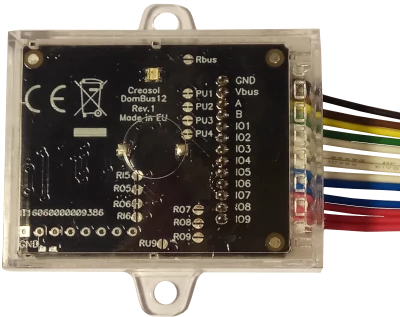 Very compact, versatile and cost-effective module with 9 ports. Each port can be configured by software as:
Very compact, versatile and cost-effective module with 9 ports. Each port can be configured by software as:
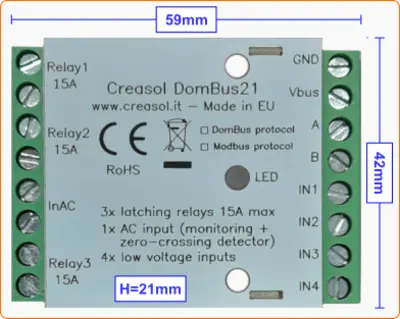 Very low power consumption module designed to enable up to 3 high power loads, up to 15A (3kW).
Very low power consumption module designed to enable up to 3 high power loads, up to 15A (3kW).
 Versatile module designed to control gate or garage door.
Versatile module designed to control gate or garage door.
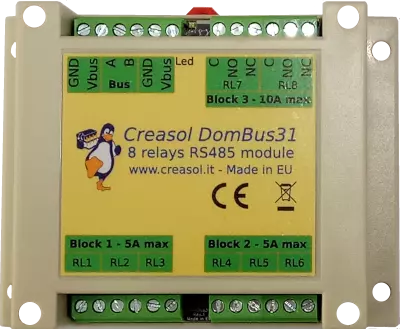 DIN rail low profile module, with 8 relays and very low power consumption:
DIN rail low profile module, with 8 relays and very low power consumption:
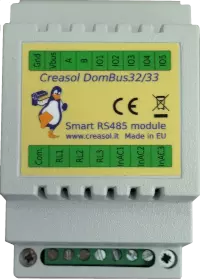 Versatile module with 230V inputs and outputs, and 5 low voltage I/Os.
Versatile module with 230V inputs and outputs, and 5 low voltage I/Os.
 Module designed to control 3 lights already existing and actually controlled by 230V pushbuttons and step-by-step relays. In this way each light can be activated by existing pushbuttons, and by the domotic controller.
Module designed to control 3 lights already existing and actually controlled by 230V pushbuttons and step-by-step relays. In this way each light can be activated by existing pushbuttons, and by the domotic controller.
Each relay can toggle the existing step-relay, switching the light On/Off. The optoisolator monitors the light status. The 5 I/Os can be connected to pushbuttons to activate or deactivate one or all lights.
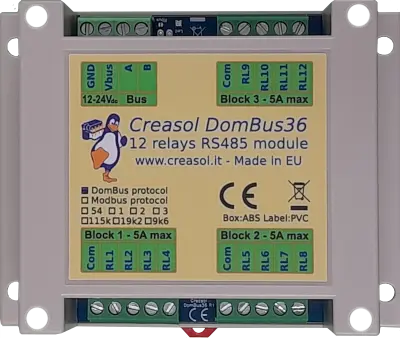 DIN rail module, low profile, with 12 relays outputs and very low power consumption.
DIN rail module, low profile, with 12 relays outputs and very low power consumption.
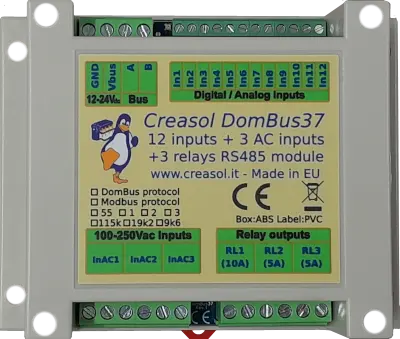 Module designed to be connected to alarm sensors (magnetc contact sensors, PIRs, tampers): it's able to monitor mains power supply (power outage / blackout) and also have 3 relays outputs.
Module designed to be connected to alarm sensors (magnetc contact sensors, PIRs, tampers): it's able to monitor mains power supply (power outage / blackout) and also have 3 relays outputs.
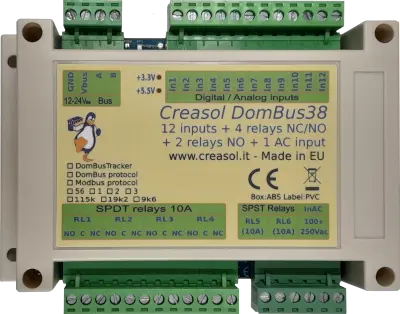 DIN rail module designed for burglar alarm system.
DIN rail module designed for burglar alarm system.
![]() DIN rail module that control azimuth + elevation/tilt motors of a sun tracker, to maximize photovoltaic energy production during the day and seasons.
DIN rail module that control azimuth + elevation/tilt motors of a sun tracker, to maximize photovoltaic energy production during the day and seasons.
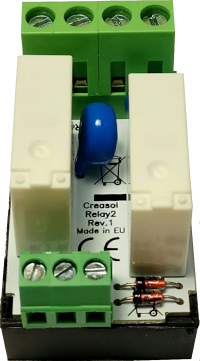 Simple module with 2 relays, to be used with DomBus modules or other electronic boards with open-collector or open-drain outputs
Simple module with 2 relays, to be used with DomBus modules or other electronic boards with open-collector or open-drain outputs
 IoT board designed for NodeMCU v3 board using ESP8266 WiFi microcontroller
IoT board designed for NodeMCU v3 board using ESP8266 WiFi microcontroller
I'm using it to dimmer a LED strip with domoticz.
Just connect the power supply and led strip, and it works without expensive external dimmers.